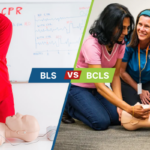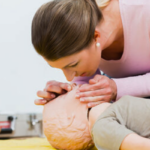
- Last Updated On: October 18, 2023
Transitioning from BLS to ACLS for Healthcare Providers
Transitioning from Basic Life Support (BLS) to Advanced Cardiovascular Life Support (ACLS), healthcare providers can now achieve a critical milestone. To handle cardiac emergencies, ACLS features cutting-edge procedures and interventions.
You can learn this skill quickly and at your speed by enrolling in the American CPR Care Association’s Advanced Cardiovascular Life Support (ACLS) certification and recertification course, which is offered to healthcare workers.
We will discuss the most important elements of the change from BLS to ACLS in this article.
The transition from BLS to ACLS for healthcare providers:
- ACLS is an enhanced skill for managing cardiac emergencies, which includes:
- Advanced Air Management
- Defibrillation
- Medication Administration
- Major technical aspects that differentiate ACLS from BLS, are interpreting ECG rhythms, administering advanced medications, and synchronized cardioversion.
- Healthcare professionals need to stay updated with the current practices of ACLS and any changes in ACLS guidelines through certification and recertification.
Importance of teamwork and communication in the delivery of ACLS care
Effective teamwork and communication are essential for Advanced Cardiovascular Life Support (ACLS) practitioners to manage emergencies and improve patient outcomes.
- In ACLS, a group of medical specialists frequently collaborates to provide immediate assistance and supervision. Effective communication ensures that each team member’s special talents and skills are developed to the fullest extent possible.
- To effectively share important information, assign roles, and carry out tasks, the team must communicate concisely.
- Effective communication aids in smooth transitions & synchronizing the team’s efforts in high-stress situations such as:
- Performing CPR,
- Giving medication
- Defibrillation
- Additionally, to function as a team, each member must be aware of their individual roles and actively engage with others.
- The team can use its assets more effectively, reduce duplication of effort, and avert potential mistakes by working together.
- To keep the environment for patient care safe and effective, each person’s participation is crucial.
- A proper team briefing can significantly improve the team’s performance. Healthcare team members can discuss:
- the intricacies of the scenario,
- create a shared model,
- define roles and duties, and
- anticipate potential challenges during these briefings.
This procedure encourages:
- good communication
- establishes a common understanding of the work at hand
- enables team members to recognize areas where their output can be boosted.
- In urgent cardiac situations, healthcare providers can deliver the highest standard of care and enhance patient outcomes by collaborating effectively, utilizing their specialties, and communicating effectively.
ACLS Certification for healthcare professionals
- The Advanced Cardiac Life Support (ACLS) certification expands on the Basic Life Support (BLS) curriculum’s core competencies and emphasizes advanced cardiac care methods.
- Doctors, nurses, paramedics, emergency medical technicians (EMTs), and other allied healthcare workers can all obtain ACLS certification.
- Medical professionals such as doctors, nurses, paramedics, emergency medical technicians (EMTs), and other allied healthcare practitioners may obtain ACLS certification.
- Advanced airway management, cardiac rhythm interpretation, pharmacology, and team dynamics in resuscitation settings are a few topics that are often included in certification training.
- Healthcare professionals must successfully complete a certified ACLS course offered by approved training institutions or organizations in order to receive ACLS certification.
- Professionals who successfully complete the course are given an ACLS provider card or certificate and it is valid for two years.
- It’s crucial to keep in mind that maintaining ACLS certification necessitates regular recertification in order to guarantee that medical professionals stay updated with the latest techniques and maintain their ACLS skill competency.
- Attending refresher courses, passing tests, and proving skill mastery could all count as prerequisites for recertification.
Cert & Recert
Healthcare professionals who wish to renew their licenses can take advantage of ACCA’s online renewal courses and carry out the certification process in the comfort of their own homes or offices.
For busy professionals who are unlikely to have time for in-person training, this flexibility is especially helpful.
The online refresher course covers important subjects like:
- effective team dynamics in cardiac emergencies
- emergency medicine
- advanced cardiovascular life support algorithms.
In order to ensure that healthcare professionals obtain exceptional education and training, American CPR Care Association makes sure that their programs adhere to the most recent standards and criteria established by illustrious groups.
Conclusion
In conclusion, upgrading from BLS to ACLS is a significant achievement for healthcare professionals. ACLS equips them with cutting-edge techniques to manage cardiac crises effectively. The American CPR Care Association provides busy healthcare professionals with flexible online ACLS certification renewal courses.






